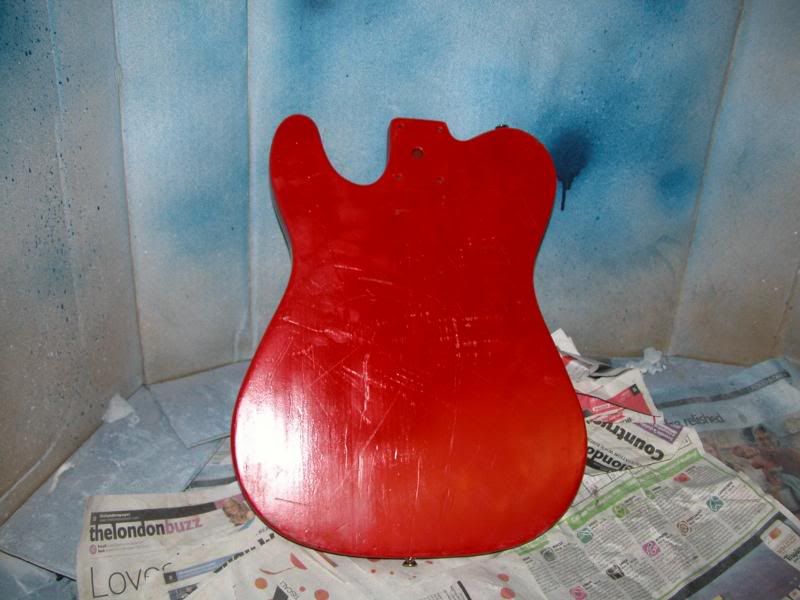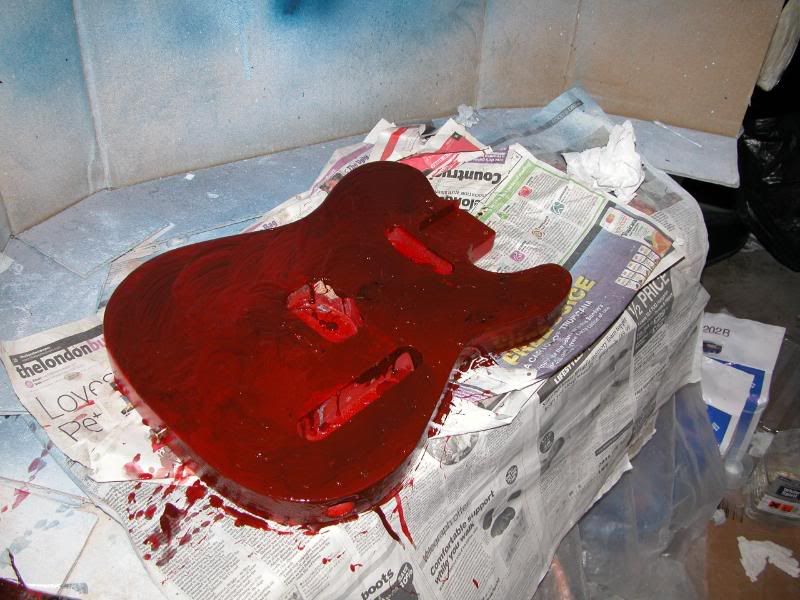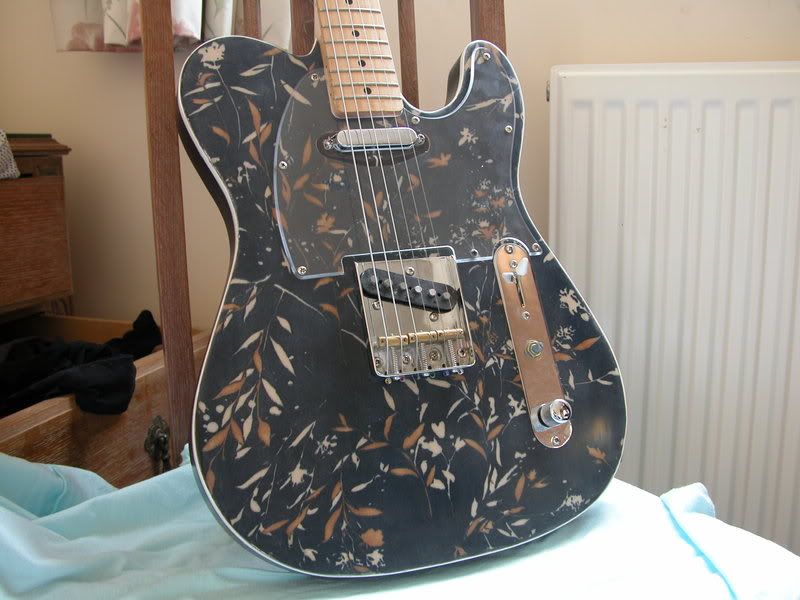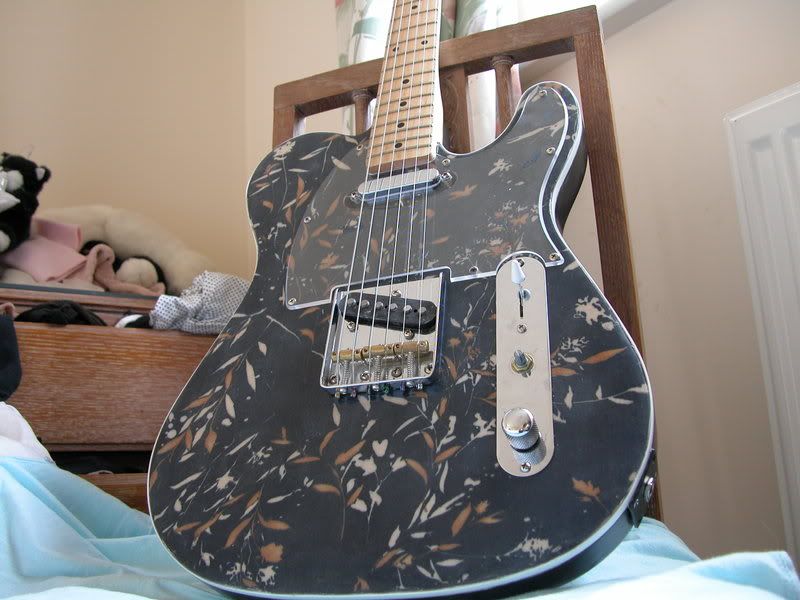|
|
Post by nickwellings on Apr 18, 2009 16:24:53 GMT -5
We all know how fun it is find a nice guitar for cheap and then to fix it up or mod it into something special. Here's one I worked on. I got it second hand, a little Squier Tele. The thing was in really bad shape, crying out to be rescued. Someone had stripped the old finish off with a chisel, leaving huge gouges, and then they'd painted it in housepaint, bright red. The poor guitar was stuck to the guitar stand cause of the paint. But I knew it had potential. Here's what I started with.   The minute I got it home, I removed the paint.  Little did I realise that it would take about a year to actually finish the thing. I had to plane the back to get rid of some of the worst gouges. Anyway, here is how it is now.   It now has a black top hat knob, chrome knob for volume. Pickups are the same old Squier ones. Believe it or not, I get a nice sound from it, and it is the guitar I use for playing 70s rock covers in a band. People like to comment on how they like it. I think I might try to do a similar thing on another guitar...but right now, I am trying to restore a Charvel Model 6 and it is kicking my ass. |
|
|
|
Post by halo71 on Apr 18, 2009 19:13:40 GMT -5
Nick!! I a, speechless! That is an amazing refinish you got there! What did you do to get that finish? Simply beautiful!
|
|
|
|
Post by nickwellings on Apr 19, 2009 7:46:38 GMT -5
Hey hey hey, Mr. Halo. Thanks, that is nice of you to say.
The secret is: It is a fabric refinish. Find some cool fabric, glue it on, seal, then lacquer like heck.
It should be way more shiney, but something is going wrong with my lacquer spray cans. The best thing would be for me to use nitrocellulose paint, but that is a strictly controlled substance over here, only car bodyshops and places like that have em. I have since found a supplier so might try out another fabric refin if I ever finish this damn Model 6 project.
|
|
|
|
Post by heem6 on Apr 19, 2009 12:51:05 GMT -5
Awesome restoration, Nick! It's so distinctive I can see why everyone comments on it! I would love to hear you play some down-home slide guitar on that thru a Marshall stack!
Lately I heard some guys praising Poly over Nitro - saying that it's easier to work with, dries faster and doesn't yellow with age. What's your opinion?
|
|
|
|
Post by halo71 on Apr 19, 2009 14:22:35 GMT -5
^ Although I kinda like the yellowing that Nito affords, the poly seems to be easier to work with. That's what I use. I've never used fabric like this but I may try too on the next project. Would like to find some urban camo fabric!
|
|
|
|
Post by nickwellings on Apr 20, 2009 16:11:29 GMT -5
I have not tried poly, Jim...but I know there is a reason it is the standard. Tough, easy to apply, high build and fast drying etc. Damn toxic though. I don't have facilities to spray it.
What I used was what is called 1 pac, which is basically rattle can spray lacquer, the lacquer is actually acrylic.
Thanks for the praise. One guy suggested I could look into doing things like that as a paying thing on the side. I had considered that, but would need a bit more practice and some better equipment.
|
|
|
|
Post by heem6 on Apr 20, 2009 20:11:55 GMT -5
You might want to consider that, Nick. I think you could ask $300 - $400 easy for a standard paintjob, more for specialty jobs.
|
|
|
|
Post by halo71 on Apr 20, 2009 21:32:10 GMT -5
Yeah I think you could make some side money! That is what I want to get to. I have the facilities (wood shop) at my house. I want to start cutting guitar bodies and sell them. My buddy has a paint booth that I have used to paint guitars. He paints motorcycles so no more than it takes to paint a guitar I usually dont have to pay for the paint.
I recently painted a HM body for Jim. Black with HEAVY pearl mixed in. Needless to say, something happened and it didnt turn out all that well. Either the paint was old or it was due to he fact it was rainy and humid outside that day. ALways heard, never paint in those conditions. Think it may be true!
|
|
|
|
Post by halo71 on Apr 20, 2009 21:38:23 GMT -5
Also Nick, what's the scoop on the white binding on the body? Did you add that?
|
|
|
|
Post by nickwellings on Apr 21, 2009 12:04:30 GMT -5
Yep, I added the binding in. Funny thing really...I did everything ass backwards really. I did the fabric top first...I think that might be sensible though, as the sealer loves to melt paint. Then I primed the back...realised I'd have this ugly sort of seam running all along the body edge so decided to do binding to try and hide it. I bought the Stewmac router set from the US, has bits precisely matched to common binding widths. I have no power tools, so I took it to a friend of mine, who is a kind of master carpetner dude. He is wary of powertools, esp routers. He prefers chisels, and the things he can do with thema re crazy. But for this we used his router. He did all the cuts. Anyway, after the channel was done I had to mask the front and the binding channel, spray the black on and all...I had two huge disasters too, I was sanding the sealed surface down to about 1200 grit using a wood block and wet/dry paper. I am merrily sanding away when I notice something....odd. Turns out I had torn a huge chunk of the fabric off, maybe 2 inches long line. I had caught a tiny tiny hole made by the router guard and just torn it...there were more of these little holes all around. I had to fill that witha tiny tiny matched piece of fabric. Turned out ok. Anyway, most times with these porjects I get impatient. I jsut wacked the binding on really fast using superglue. If you look closely at it, it has discoloured bits ina few places from where I got stuck to it. Superglue is NOT the recommended binding applying material...!!  Another minor flw was that the lacquer somehow reacted witht he plastic pickguard in two places and left huge crystaline formations on it. Kind of stuck to the pickguard. So I had to sand that down the other week. Like I say, I am goign to try Nitro next. And if you think mine are nice, check what THIS GUY does with fabric and nitro. www.jaiguitars.com/home.htmlSome of them are sick looking. And it is EASY and quick to do, really. I got the idea from him. |
|
|
|
Post by halo71 on Apr 21, 2009 14:56:36 GMT -5
Nick, I still give ya props though! I think you did very well on this project! I even posted your pics and a little info on 2 other guitar sites I haunt and its gotten rave reviews! I have seen fabric finishes before but never thought about using that. I think on my next project I may try to do something like that! THe binding you did really sets it off I think!
How many guitar projects have you done? I have a Westone Dana body that I have been working on a bit here and there. I wanted to do a natural finish (tung oil) on it. But after removing at least 3 colors of paint and getting to the wood. It's not prety enough for a natural. I had plans of painting it in a bright orange with heavy pearl mixed in. But I may try the fabric route.
|
|
|
|
Post by nickwellings on Apr 21, 2009 17:35:12 GMT -5
Hey that's nice of you to post it around, Halo! I'd like to see eventually what the thoughts are.
Kind of makes me wish I put another knob on it before shooting the pics!!
I like how the binding turned out too. It was a pain to get it routed, and there was a few bits of tear out and other worries to get over. Maskng was the most important thing all aroud I think. Mask the face to spray the back, the rout to spray the sides, then for gluing binding, mask the sides and so on...
This is my 2nd project, the first was the HM I did. I had thought fabirc would be easier, which is why I did it. In a way, it is. Case you can find some really nice patterns and designs. But doing the tele was pretty labour intensive. It might go easier on a normal unblemished strat body, I hope.
I managed to find a Vigier guitar neck for pretty cheap, a 24.80 scale length one, so I was hoping to mate that into a new fabrically finished body.
The nicest thing, for me, is that I bought the fabric from a local shop here. Y'know, supporting local industry and talent.
£5 for a yard of fabric,
Sanding sealer, approx £6
2 or so cans of lacquer, approx £12.
Misc things like tape, binding, say £10.
Not too pricey either.
I have never tried tung il before but I have heard a lot about it. It is actually very hard to get here, I think.
Oh yeah, I meant to say. Right after those pics were done, I was soldering up some newer connections, and managed to someone touch the side of the iron onto the guitar face. I have a big melted gouge out of the face now, under the control plate. That wasn't too fun to watch.
Anyway, ebay is a good place to get fabric. For fabric like that dude's finishes, Japanese stuff, Kona Bay's website is good. Obviously quilting and patchwork is huge now, and there's just amazing ranges to choose from. I just lucked out with this locally sourced piece!
$300 is a good priceing idea, Jim. That's a nice figure...I'd have to practice it a whole bunch more though.
*off to ebay to look for fabric and old guitars*
|
|
|
|
Post by heem6 on Apr 22, 2009 0:43:48 GMT -5
So how does the lacquer process go? I just have this visual in my head of the fabric soaking up the lacquer and becoming a big soggy mess...
Obviously your results say otherwise, but how does that work?
|
|
|
|
Post by nickwellings on Apr 23, 2009 8:17:08 GMT -5
Well it was a while back, nearly a year now... so I will try to recall.
Bare wood body>fabric cut to shape, glue on. Yes, the important part is Sealing the body with sanding sealer. I used big gloopy paste sealer, but much better results would be obtained with spray I am sure. The real fabric is a dark midnight blue, whereas on the guitar in real life it is a lot lighter.
I took the guitar to show the fabric shop owner. He was very impressed. Whilst I was there, I bought some really nice gold coloured fabric with blue patterns. Might try another Tele...!
|
|
|
|
Post by heem6 on Apr 23, 2009 12:27:24 GMT -5
I still think that yours looks great and mine would look like a big, gloppy mess!
|
|
 />
/>
 />
/>